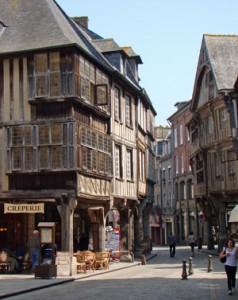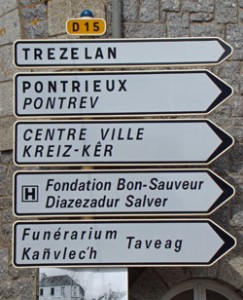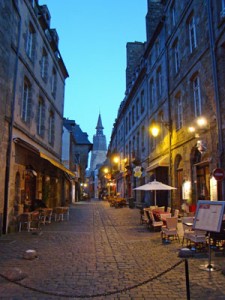 I went to France in search of my father’s roots.
I went to France in search of my father’s roots.
I’ve written once before about my quest to uncover my grandfather’s story. My brother and I have been sleuthing through online genealogical records and have finally assembled a pretty solid family history of the French branch of the tree, going back to around 1600. The family hailed from Brittany, a province in the northwest corner of France.
Armed with our findings, my wife and I went on a two-week trip to France to look for more connections to the past.
Brittany is an ancient region originally settled by Celtic tribes. Culturally and linguistically unique (the Breton language is still spoken in some areas and appears on many highway signs), it transports you back to medieval times with its well-preserved walled cities, castles and tilting, half-timbered houses.
 Brittany lies adjacent to and just west of Normandy, site of the D-day beginning of the liberation of Europe in 1944. We flew to Paris (unknowingly, just minutes ahead of the Iceland volcanic eruption), rented a peppy Ford Fiesta 5-speed from Hertz and, armed with a new GPS, bravely merged into Paris’ insane rush hour. We headed north to a bed and breakfast in the little town of Ryes in Normandy, just a short trip from the American military cemetery at Omaha beach.
Brittany lies adjacent to and just west of Normandy, site of the D-day beginning of the liberation of Europe in 1944. We flew to Paris (unknowingly, just minutes ahead of the Iceland volcanic eruption), rented a peppy Ford Fiesta 5-speed from Hertz and, armed with a new GPS, bravely merged into Paris’ insane rush hour. We headed north to a bed and breakfast in the little town of Ryes in Normandy, just a short trip from the American military cemetery at Omaha beach.
I’ll be writing about various aspects of my trip as I find time over the coming weeks. Traveling in another country can be a stretching and enlightening experience, if you go with an open mind to the many cultural differences you’ll find there. I don’t find it very easy to make that adjustment to new cultural rules and values, new foods, new languages and customs. But I find it all very interesting, and I think it forces me to examine my American habits and beliefs more objectively.
The Normandy and Brittany country sides were beautiful, and it seemed to me that every twist and turn in the road brought us to another scene that could have been lifted from a postcard. The area reminded me of piedmont North Carolina, or perhaps rural Wisconsin. Cramped little villages barely changed over centuries are separated by long stretches of empty, rolling farmland, lush woods and meandering rivers. The same roads that used to transport horse carts have been slightly improved for the automobile, and were busy with huge tractors moving from field to field, plowing and planting this season’s crops.
Everywhere we went we were met by green fields planted in hay, bright yellow fields of rapeseed (harvested to make canola oil), rich brown fields under cultivation, roadsides dotted with wildflowers, blooming cherry trees, and gardens lovingly planted with gaudy tulips and a profusion of brightly-colored annuals.
I live in a desert, where the color green appears only briefly in the spring, and growing stuff in this rocky soil takes hard work and a lot of luck. In Brittany, it appears that anything that touches the earth grows vigorously, lushly, effortlessly. It was quite beautiful.
As we drove through little towns and big cities, it became apparent that to the French, living in the midst of beauty is a very high cultural value. Streets were lined with carefully manicured trees, and the trees themselves were selected and planted to give the most pleasing view as you passed by. Flower gardens were lovingly nurtured, not only in public parks, but in the private yards beside suburban homes, country farmhouses, and in thousands of window boxes hanging from city apartments. Tulips are a favorite flower, and everywhere we went we saw new colors ranging from deep purple to red, orange, yellow, and too many variegated combinations to count.
 Another apparent value is the preservation of old things and old traditions. Centuries-old stone farmhouses are everywhere, carefully maintained and updated, but passed down from generation to generation. The oldest sections of most cities and towns contain whole neighborhoods where residences and shops date back to the 18th and 19th centuries, and the churches are older still.
Another apparent value is the preservation of old things and old traditions. Centuries-old stone farmhouses are everywhere, carefully maintained and updated, but passed down from generation to generation. The oldest sections of most cities and towns contain whole neighborhoods where residences and shops date back to the 18th and 19th centuries, and the churches are older still.
Even in places like St. Malo, the historic, walled city so devastated in August, 1944, by a battle to drive the Nazis from the coast of France, residents chose not to sweep away the rubble and start new, but to repair the damaged old buildings and preserve their history.
The soul of France is ancient, going back to Roman times and earlier, and though they embrace modernity (high-speed trains and nuclear power), the French have worked hard to honor and preserve their roots, their history, their heritage. It’s not an easy balance, holding fast to tradition while moving into the future.
In some ways, the French have failed to preserve what was best about their past, most notably, their deeply personal and historic commitment to the Christian faith. Gorgeous, ancient cathedrals stand empty except for gawking tourists armed with cameras — like me! But those cathedrals still stand, and perhaps they will remind France of something valuable that has been lost and can yet be regained.
Perhaps that reawakening has already begun. In a number of French cathedrals, I saw posters inviting people to participate in The Alpha Course, a video-based discussion program first started in England as a way to introduce a new generation to the ancient truths of Christianity.
I hope you enjoy the photos and my impressions of France. I’ll have more to share as the days go by.


The first picture takes my breath away…like looking into a story book. What a lovely description of the country. It must be gratifying to have ancestral roots there.
This is what I love about Europian towns and villages. The narrow winding roads are always filled with friendly people and there is always something interesting around the next bend.
Thanks for sharing your impressions of your trip with us, Charlie, I look forward to future installments. Your comments remind me of my own experiences in Europe and make me want to go back…